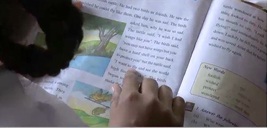2 Reading aloud to your students
By reading books aloud and following the words on the page with your finger as you do so, you will help your students to understand that print carries meaning. They will learn how to hold a book and turn the pages, and how texts are sequenced from beginning to end, left to right and top to bottom.

As you model good reading practices, your students will copy you. They will try to ‘read’ books independently, sometimes recalling the words of a story from memory, using the pictures as prompts and sometimes making up the story themselves, drawing on their experience and imagination. These are all encouraging signs that they are developing reading practices, so be sure to notice and encourage them as they do so.
Case Study 3: A reading role model
Ms Saroj is an elementary teacher in Bihar. Here she describes how she tries to be a reading role model for her young students.
Whether it’s a poem or short story, I read aloud to my students every day. I open the book very deliberately, turn the pages carefully, select a poem or story, and read it with expression, following the text with my finger and showing my students the accompanying illustrations. I often read the same poem or story more than once on different occasions.
Since I have been doing this, I notice that my young students have started to handle books more carefully, holding them the right way up, turning the pages one by one, looking at the pictures attentively and, sometimes, moving their fingers under the words. By observing them in turn – noting which of them is looking at the pictures, pretending to read, attempting to read or reading most or all of the words – I can monitor their individual progress in developing this skill.
Activity 3: Reading aloud to your students
Using Case Study 3 and Resource 2 for reference, plan, implement and evaluate your own reading aloud session with your students. Discuss your ideas and reflections with a colleague if possible.
The next section describes some of the strategies that young students use in their early reading.
1 Beginning to read – ‘Who?’, ‘What?’, ‘Where?’, ‘Why?’
